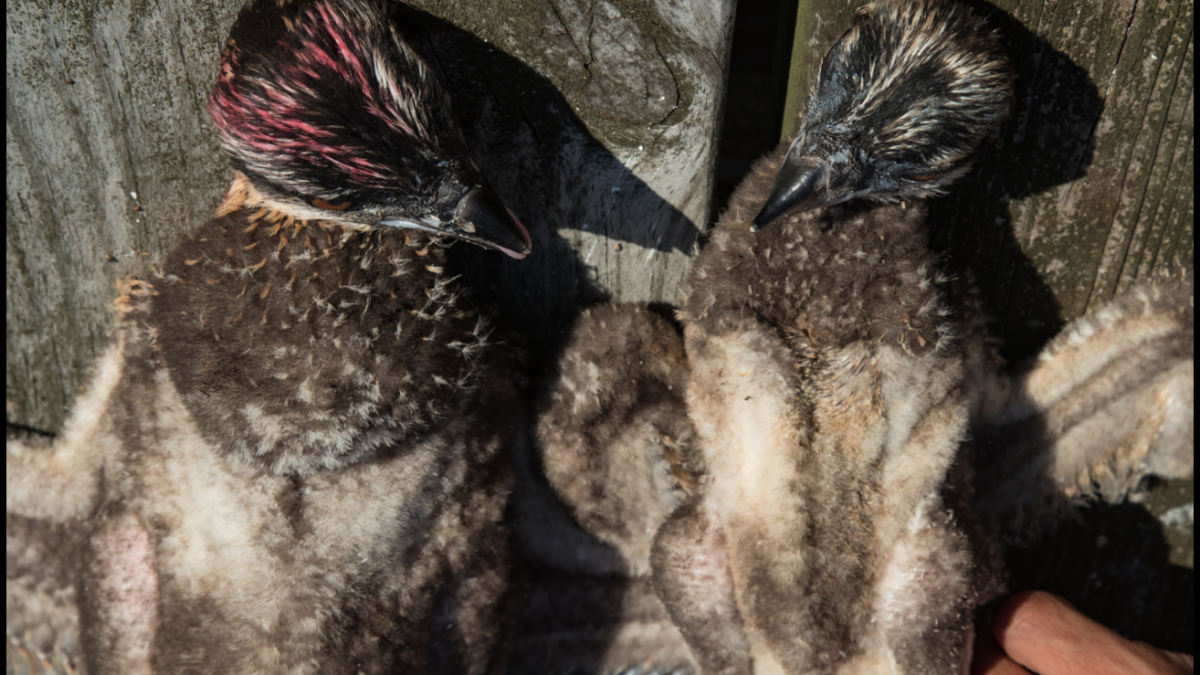Recent Literature published by CCB

The 2024 Osprey Field Season
July 18, 2024
Lower Susquehanna Eagles
July 18, 2024A brood of osprey in Mobjack Bay showing a well-fed chick (left) and an emaciated chick (right). The chick on the right would die the following week due to starvation. Work in Mobjack Bay over a 40+ year period has shown that both reproductive rates and food delivery rates have declined dramatically. The decline in provisioning has led to an increase in brood reduction or chick loss due to starvation. Photo by Bryan Watts.
By Bryan Watt
7/13/24
In recent months CCB biologists have published several papers in academic journals. These articles report on recent findings and are intended to spread the word to the broader conservation community. Our continuing hope is that our research will initiate positive change.
Demographic response of osprey within the lower Chesapeake Bay to fluctuations in menhaden stock.
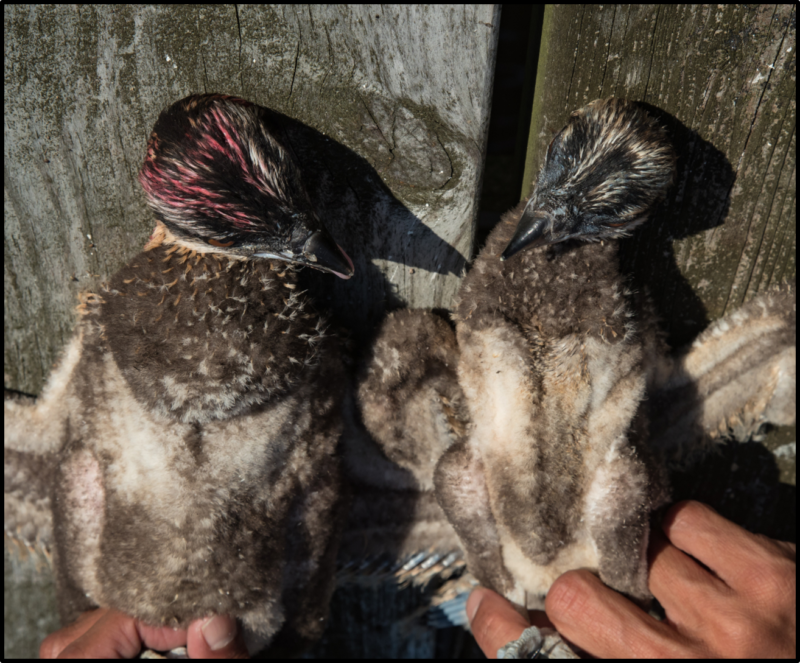
Abstract – Forage fish support the largest fisheries in the world and play a vital role in marine food webs by transferring energy from plankton to consumers within higher trophic levels. Growing commercial demand for these species and concern for the impact of over harvest on predator populations has driven a paradigm shift in management objectives from maximizing economic return to the establishment of ecosystem-based limits on harvest rates. How well current harvest policy supports noncommercial species like piscivorous birds remains poorly understood. We investigated the relationship between osprey breeding performance within the lower Chesapeake Bay and a menhaden stock index during a period (1974-2021) when the menhaden index fluctuated over 35-fold. Reproductive rate (young/pair/year), brood provisioning (fish/10-h) and the proportion of menhaden in the diet all declined during the study period. Indicators of food stress including brood reduction and nest failure increased during the study period. The population transitioned from reproductive surplus (demographic source) to reproductive deficit (demographic sink). A significant relationship between reproductive rate and the menhaden index suggests that osprey population viability requires that the menhaden stock be restored to 1980s levels. Current ecological reference points based on the food requirements of predatory fish are unlikely to protect the osprey population. We suggest the establishment of menhaden or reproductive thresholds designed to allow osprey to meet demographic targets (1.15 young/pair/year).
Exposure of peregrine falcons to halogenated flame retardants: A 30 year retrospective biomonitoring study across North America.
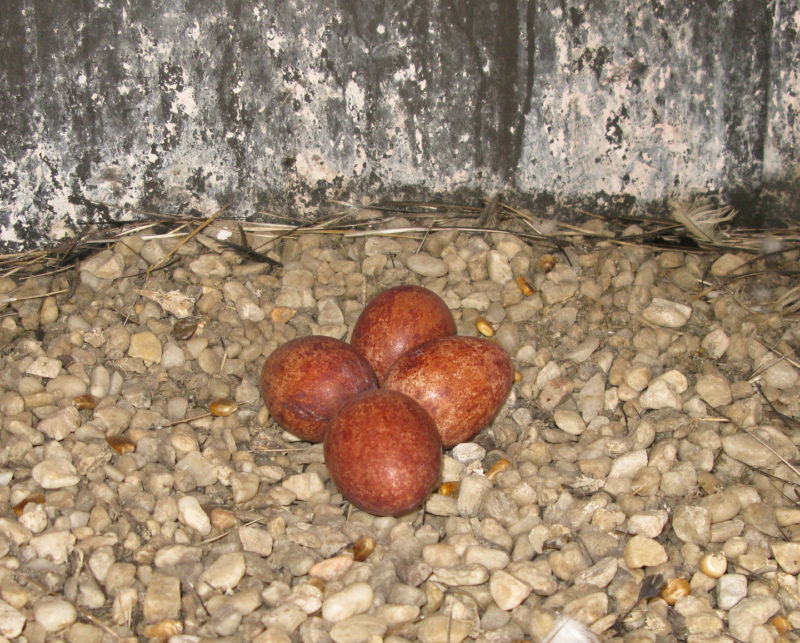
Abstract – Compared to aquatic ecosystem, terrestrial systems have been subjected to fewer investigations on the exposure to halogenated flame retardants (HFRs). Our study utilized peregrine falcon eggs collected from multiple habitats across North America to retrospectively explore both spatial distribution and temporal changes in legacy (e.g., polybrominated diphenyl ethers) and alternative HFRs over a 30 year period (1984−2016). The results reveal intensive HFR exposure in terrestrial ecosystems and chemical-specific spatiotemporal distribution patterns. The correlations between egg levels of the selected HFRs and human population density clearly illustrated a significant urban influence on the exposure of this wildlife species to these HFRs and subsequent maternal transfer to their eggs. Temporal analyses suggest that, unlike aquatic systems, terrestrial ecosystems may undergo continual exposure to consistently high levels of legacy HFRs for a long period of time. Our findings collectively highlight the effectiveness of using peregrine eggs to monitor terrestrial exposure to HFRs and other bioaccumulative chemicals and the need for continuous monitoring of HFRs in terrestrial ecosystems.
Night roosts of double-crested cormorants in coastal North Carolina.
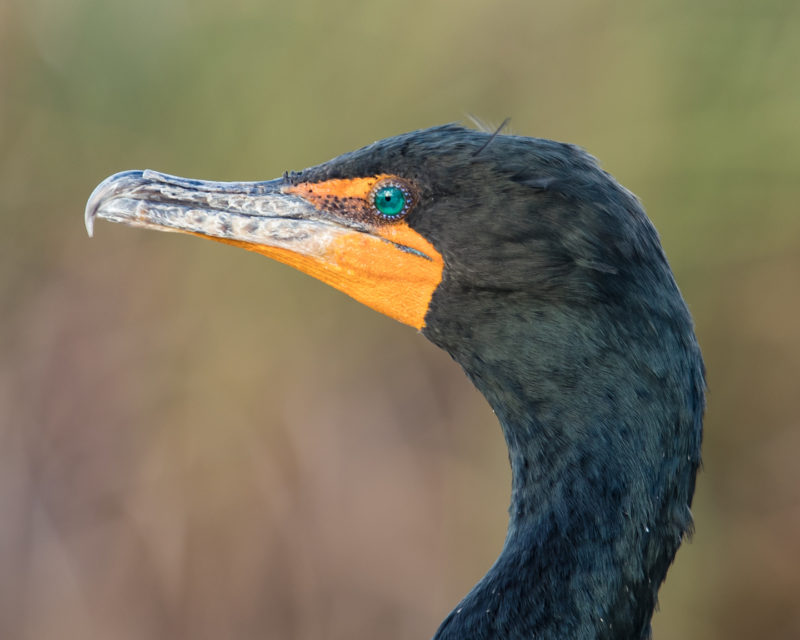
Abstract – Communal roosts are essential landscape features for many bird species and represent opportunities for population monitoring and management. I used a fixed-wing aircraft to survey a network of night roosts in coastal North Carolina used by Nannopterum auritum (Double-crested Cormorant) during the nonbreeding seasons of 2019–2021 to estimate population size and to characterize habitats used for roosting. Cormorant numbers peaked around 145,000–195,000 during southward migration, reached a low of 44,000–46,000 in winter, and then increased to 55,000–77,000 during northward migration, suggesting that the study area may serve primarily as a migratory staging site for most of those birds. Cormorants roosted on the ground on sandy islands (n = 8), intertidal sand bars (n = 11), and barrier beaches (n = 5). Sandy islands had the highest consistency (71%) and overall use accounting for 56% of roosting activity. Sand bars were used more consistently than barrier beaches (52% vs 33%) but accounted for less activity (16% vs 28%). Cormorants roosted on sand bars primarily during periods when high tide was <0.15 m and on barrier beaches when vehicles were not using the beach. The size of roosting groups varied dramatically from 12 to >93,000 with a median of 1005, and the distribution of group sizes (n = 114) was highly skewed to smaller groups, with 45 of <500 birds, 21 of >10,000 birds, 11 of >20,000 birds, and 4 of >40,000 birds. Group size varied between substrate types, with beaches supporting the largest median group size (8250 individuals) compared to sandy islands (1850) and sand bars (457). Coastal North Carolina supports a large number of Double-crested Cormorants during the nonbreeding season. Cormorants roost on open sandy areas that are isolated from ground predators and free from human and tidal disturbance.
Habitat associations for eastern black rail (Lateraluus jamaicensis jamaicensis) in south Florida.
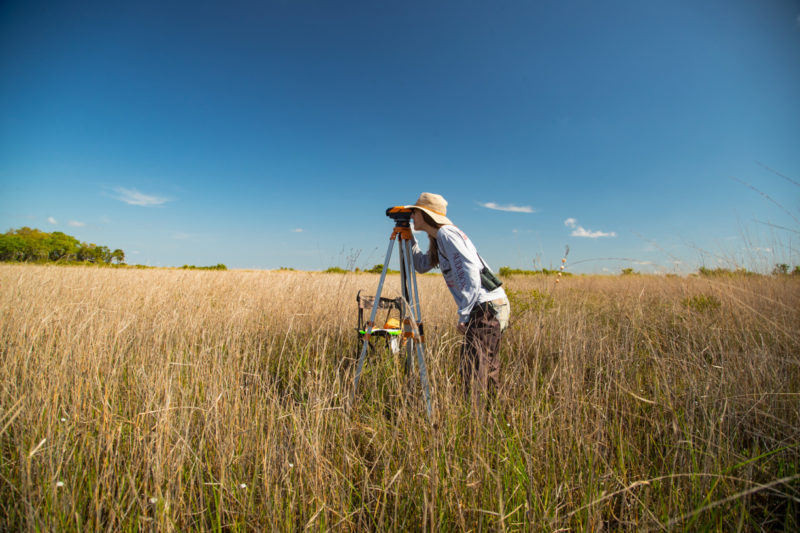
Abstract – Identification of important habitat features can help facilitate recovery for threatened and endangered species, but this information is not always readily available prior to implementing management actions. The Eastern Black Rail (Laterallus jamaicensis jamaicensis) was recently listed as federally threatened and management efforts are shifting toward inland locales in lieu of the coastal areas where the species was historically found to avoid the effects of ongoing sea level rise. Little is known about inland Eastern Black Rail populations, so we examined habitat parameters that were important to predicting occupancy of the South Florida Everglades population. We found that saturated soils, topographic heterogeneity, and herbaceous cover had a positive effect on occupancy and the number of trees was negatively associated with occupancy. We also found that extinction rates were higher for locations that dried between years. While hydrology and herbaceous cover are known to influence Black Rail occupancy for coastal Eastern Black Rails and inland California Black Rails (L. jamaicensis coturniculus), the effect of topographic heterogeneity is novel and represents a potential feature that land managers can manipulate to increase inland habitat suitability for the Eastern Black Rail.
Current distribution of black rails in Florida.
Abstract – The Eastern Black Rail (Laterallus jamaicensis jamaicensis) subspecies has experienced drastic contemporary regional population declines and in 2020 was federally listed as Threatened under the Endangered Species Act. Population trends in much of its range remain unknown, however, because it is understudied and notoriously difficult to detect. Florida is presumed to be one of the remaining strongholds for the Eastern Black Rail, but a population survey has not been conducted in more than two decades. We conducted 1,314 Black Rail surveys at 438 points in 2016 and 2017 throughout Florida, and an additional 731 surveys at 287 points in 2020 in South Florida. We detected Black Rails at just 39 points on 15 of the 28 (54%) surveyed public properties during all three survey years. Six additional properties are currently occupied by Black Rails, as indicated by opportunistic sighting records from other trained biologists during the past ten years, resulting in 21 total occupied properties in 19 Florida counties. Occupancy and detection rates were too low to allow for any formal statistical analysis of the survey data. The timing, location, and frequency of our surveys may have contributed to the lack of detections during our surveys, and more work is needed to understand how best to survey this elusive species. Nevertheless, it seems likely that the paucity of detections is at least in part due to the rarity of the species, and intensive monitoring, research, and management will likely be needed to recover the species.
Assessment of body size and sexual size dimorphism in Haliaeetus leucocephalis (Bald Eagles) of the Chesapeake Bay.
Abstract – We measured eight morphometric parameters to characterize body size and sexual size dimorphism in Haliaeetus leucocephalus L. (Bald Eagle) from the Chesapeake Bay. Linear measurements, including culmen length, culmen depth, hallux length, tarsus length, wing chord, length of 8th primary, and tail length, were made from museum specimens that were exclusive to the Chesapeake Bay population. We obtained mass data from the National Wildlife Health Center’s Bald Eagle necropsy program. Bald Eagles from the Chesapeake Bay showed some level of reversed sexual size dimorphism in all characters examined. Mass and tarsus length exhibited the highest dimorphism index. On average, females were more than 30% heavier than males, with a tarsus that was 17% longer. Body size for Bald Eagles in the Chesapeake Bay is larger than in southern populations and smaller than in northern populations, supporting earlier evidence of clinal variation with latitude.
Status and distribution of colonial waterbirds in coastal Virginia: 2018 breeding season.
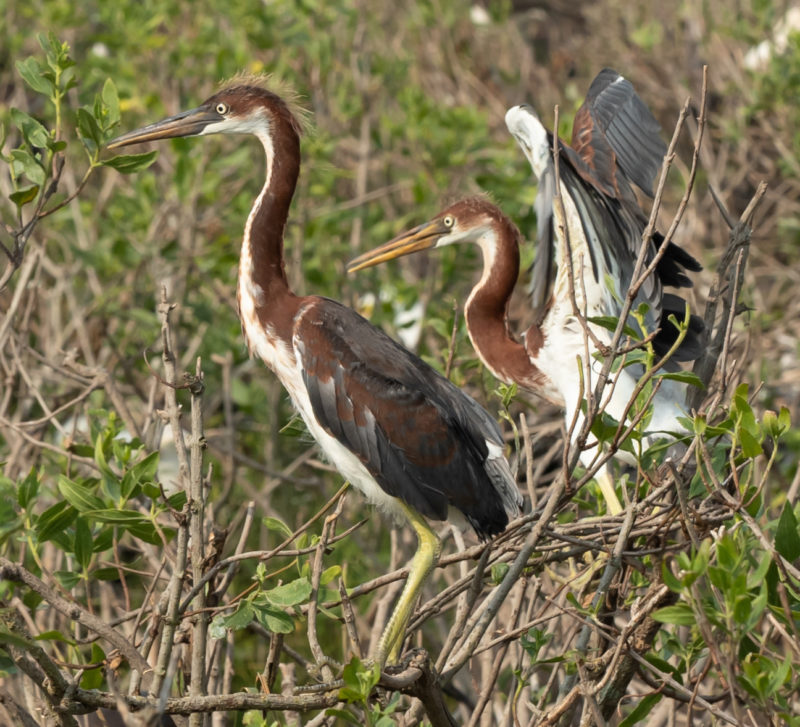
Abstract- We surveyed 270 waterbird colonies during the breeding season of 2018. Colonies supported an estimated 43,159 breeding pairs of 23 species. Gulls were the most abundant group with more than 19,700 breeding pairs. Terns and waders accounted for 7,129 and 6,386 pairs respectively. Although they have declined dramatically, Laughing Gulls (Larus atricilla) continue to be the most abundant species and were three times more abundant than any other species, accounting for nearly 40% of the total waterbird community. The barrier island/lagoon system of the Eastern Shore was the most important region for the majority of colonial species encountered. In 2018, this region supported 22 of the 23 species evaluated. The Eastern Shore accounted for 50.5% and 46.6% of all breeding pairs and colonies respectively. For 17 of the 23 species, the region supported more than 50% of the known coastal population. The colonial waterbird community as a whole in coastal Virginia has declined dramatically since 1993 (2018 survey did not include Great Blue Herons [Ardea herodias] or all Great Egrets [Casmerodius albus]). Population estimates for 15 (68%) of the 22 species assessed declined between 1993 and 2018. Declines varied considerably between species with 14 species declining more than 40% and 9 species declining more than 60%. Cattle Egrets (Bubulcus ibis) showed the highest loss rate (-96.7%), declining from an estimated 1,459 to only 48 pairs. Little Blue Herons (Egretta cerulea) declined by 83% from 374 to only 64 pairs. Seven species increased between 1993 and 2018. Dramatic expansions were documented for White Ibis (Eudocimus albus), Double-crested Cormorant (Phalacrocoraxauritus), and Brown Pelican (Pelicanus occidentalis).

